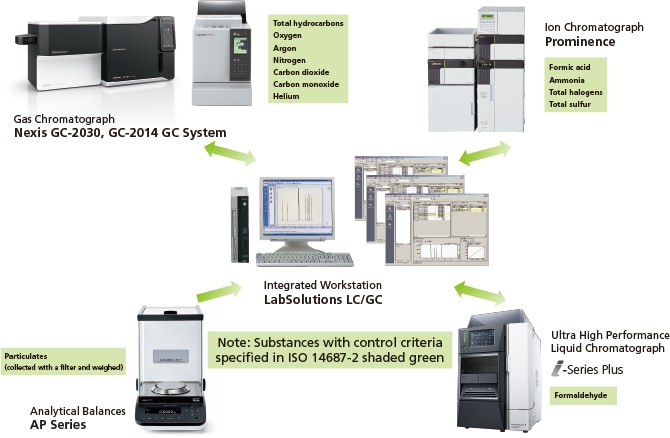
Renewable Energy/Environmentally-Friendly Materials
We also contribute to researching renewable energies and new environmentally-friendly materials, which are essential for the future of humankind and society. As economic growth and development progress globally, demand for energy continues to expand and there is increasing anticipation for technologies related to renewable energies for achieving a sustainable society. Shimadzu analytical and measuring instruments contribute to research and development of power generated from biofuels, biomass, or hydrogen, and to development of new environmentally-friendly materials with low environmental impact derived from nature.
Quality Control of Hydrogen Fuel
Strict purity standards (ISO 14687-2) are specified for hydrogen used in fuel cells. If the hydrogen contains carbon monoxide or sulfur components, it can break down the catalyst in the fuel cell. Shimadzu analytical instruments are useful for analysis involving in confirming compliance with the many quality control criteria specified in the standard for hydrogen fuel used in fuel cell vehicles (ISO 14687-2). Using LabSolutions LC/GC integrated workstation software enables the control and data analysis for multiple analytical instruments from a single workstation.


Quality Control of Algae Biofuels
Algal biomass is attracting interest as a new renewable energy alternative for petroleum resources. As a way of recycling CO2, some researches on efficient fuel production by using the emitted CO2 for the cultivation of algae are also being conducted. The quantity of biomass in culture solutions containing algae can be evaluated by using a total organic carbon (TOC) analyzer to measure the quantity of carbon in the solution.
That technique is used to obtain reliable quantitative results. Similarly, cell quantities can be quickly and easily measured and evaluated using a UV microalgae analysis system. The squalene oil (C30H50) produced by the algae contains as many hydrocarbons as heavy oil, so it must be reformed with a catalyst. GC-MS systems are useful for measuring the decomposition products generated from such catalytic reactions.

TOC-L Series

GCMS-QP2020 NX

UV-2600i
Measuring Moisture Content in Wood Biomass Fuel for Power Generation
For wood biomass power generation, measuring the moisture content in wood chips used as fuel is extremely important, because it is closely related to the amount of heat generated, ignitability, and combustibility. Therefore, the moisture content of wood chips must be carefully measured at the delivery point. The conventional method used involves potential sources of human error, such as drying the chips for a given period in a temperature-controlled chamber, determining the moisture content based on the weight difference before and after drying, and the manual process of recording the weights. In contrast, that complicated measurement process that previously required several hours to complete can be accomplished in only tens of minutes using a Shimadzu MOC63u electronic moisture analyzer. The moisture analyzer can also save transcribing time by sending measurement data directly to a computer, so that data can be acquired more quickly and accurately. That helps to create a more efficient working environment.

and MOC63u Electronic Moisture Analyzer
Basic Optical Technology Utilized for Artificial Photosynthesis Research
Artificial photosynthesis is technology for artificially performing photosynthesis using a photocatalyst and sunlight. It is anticipated as a next-generation renewable energy source, based on converting light energy into useful compounds. Evaluating the quantum yield (photoreaction efficiency) requires measuring the number of photons absorbed, which was conventionally measured using a chemical actinometer. The Lightway (model PQY-01) photoreaction evaluation system is a unique instrument that can quickly and accurately measure the number of photons absorbed without using a chemical actinometer.
The system was developed by Shimadzu Corporation, under the guidance of Professor Osamu Ishitani and Assistant Professor Yusuke Tamaki of the Department of Chemistry, School of Science, Tokyo Institute of Technology.


Environmentally-Friendly Materials - Data Analysis of Cellulose Nanofibers Properties
Cellulose nanofibers (CNFs) have gained attention as a sustainable plant-based carbon-neutral material that is very environmentally compatible. CNFs must be evaluated based on fiber length, fiber thickness, dispersion, and other parameters. Nano-3D mapping functionality of a scanning probe microscope (SPM) can be used to visualize the dispersion within a composite material by overlaying an elastic modulus image on an image of the 3D shape of the CNF composite material.


